Adobe Commerce is the fully featured eCommerce solution from Adobe—Magento Commerce and Adobe Commerce Cloud consolidated into one. It is the enterprise edition of Magento Open Source (formerly Magento Community). To help you identify the digital commerce system that’s right for your business needs and goals, we’ll talk about the different features these two applications offer and answer the following questions:
- What are the advantages of using one solution over the other?
- If Adobe Commerce is based on the same platform as Magento Open Source, does it bring enough value to offset the additional investment it entails?
- Should you upgrade from Magento Open Source to Adobe Commerce?
Magento Open Source
Magento Open Source is a self-hosted platform that allows you to build an online store with all the basic eCommerce capabilities from the ground up. It has the following features out of the box:
- Site search
- Catalog management
- Integrated checkout, payment, and shipping
- Instant purchase
- Mobile optimized shopping
- Global selling
- WYSIWYG Page Builder
- Access to extensions via Adobe Commerce (Magento) Marketplace
Being open-source, the software is free to use and has a very active community that develops the platform—qualities that are also its greatest advantages. A global community of developers works together to respond to various use cases and business needs, enabling an eCommerce ecosystem that powers over 200,000 online stores or around 10% of all eCommerce sites worldwide.
Setup and installation
The first step to installing Magento Open Source is setting up your server and hosting. You can use any hosting service as long as the server meets the Magento system requirements. Once you’ve created a database on your host, you can proceed to install Magento and get started with your new eCommerce store.
You may use the default Magento theme or customize it when setting up your online store. Purchasing a third-party theme will ease the setup process, but creating a theme from scratch is also an option.
Associated costs
While the platform itself is free, using Magento Open Source entails costs related to hosting, extensions, themes, customizations, etc. The solution has many important built-in features as outlined above, but setting up an eCommerce store that serves precisely what a business needs requires additional work.
There are many free extensions available on Adobe Commerce (Magento) Marketplace that you can download and use right away, a welcome benefit if you want to get more functionality without putting in additional investment. Most companies, however, pay for premium Magento extensions to get more features, better functionality, regular updates, and reliable support. Extensions are usually bought to enhance the store’s functionality related to payment processing, content management, customer support, marketing, site security, and optimization.
Mobile commerce
Magento Open Source has great features and functionalities for mobile commerce. There’s mobile-friendly checkout, mobile-optimized shopping support, and themes built based on a responsive web design. Then there’s PWA or Progressive Web App—a web application that gives you not only an eCommerce website but also a mobile app!
Worthy of mentioning here is ScandiPWA, the first open-source Magento PWA theme. Ready to use and fully customizable, it is the fastest way to set up a Magento store as a PWA.
Without requiring any middleware, ScandiPWA supports 350+ Magento features, conventional extensions available on Adobe Commerce (Magento) Marketplace, and A/B testing with Mosaic. And with readymage—the first and only PWA-focused hosting for Adobe Commerce and Magento 2—you can get development and production environments available in just 15 minutes.
Maintenance
Maintaining your Magento Open Source eCommerce store could be all on you if you have your own development team. Or you can hire a third-party Magento development agency to take care of site maintenance for you. Either way, an important factor to consider is that Magento Open Source regularly gets updated, so your team or the agency you’re getting needs to be able to keep up with the latest developments. You can always ask the Magento Community for help in resolving issues you encounter, but you cannot rely on it for support.
Scalability
Much as Magento Open Source has all the basic functionalities to get your eCommerce store running successfully, an important downside to it is scalability. If your business is growing very fast, you can outgrow the platform because of its database limitations. Magento Open Source only supports a single database system, which means your website could perform slower if you have multiple websites and storefronts.
Adobe Commerce
Adobe Commerce is an eCommerce solution that has all the features available to Magento Open Source plus many more, including:
- Advanced marketing tools
- B2B functionality
- Customer loyalty tools
- Live Search
- Business intelligence dashboards
- Visual merchandising
- Customer segmentation
- Gift cards
The following Page Builder functionalities are only accessible to Adobe Commerce:
- Content staging and preview
- Dynamic blocks
- Native integration with product recommendations
Adobe Commerce on cloud infrastructure is a fully managed platform that comes with additional tools and support from Adobe, such as:
- Cloud onboarding support
- Performance monitoring tools
- Enhanced security with Fastly WAF and DDoS services
- Cloud availability SLA up to 99.99%
- Streamlined updates and testing
- Customer Success Manager
- Technical support
- Global availability
Adobe Experience Cloud
Adobe Commerce is offered as part of Adobe Experience Cloud, a collection of solutions designed to help businesses make informed decisions and deliver enhanced customer experiences based on insights and data.
Adobe Experience Cloud products include applications and services covering content & commerce, data & audiences, customer journeys, marketing workflow, and digital enrollment.
Adobe Commerce is the platform where the commerce experience is unified across different channels. It has integrations with Adobe Experience Manager, Adobe Analytics, and Adobe Target. Through Adobe Commerce, merchants gain access to the business intelligence services offered by Adobe, as well as the machine learning and personalization capabilities powered by Adobe Sensei.
Cloud infrastructure
Adobe Commerce is cloud-ready with a fully redundant multi-cloud hosting infrastructure that provides optimized performance, resilience, and elastic scalability. You can efficiently run your commerce platform on Fastly’s content delivery network (CDN), and with New Relic for monitoring and management you can keep your store environment running smoothly.
Adobe Commerce offers all the benefits of modern cloud computing that are most commonly associated with SaaS solutions: elastic scalability, high resilience and availability, PCI compliance, and global availability and automated patching, while still maintaining flexibility in software customization that our merchants require.
Source: Adobe Experience League
The main reasons eCommerce companies choose Adobe Commerce on cloud infrastructure include decreased ongoing/maintenance costs, reduced capital expenses, better time-to-market, improved scalability, and enhanced security.
As a platform-as-a-service (PaaS), Adobe Commerce on cloud infrastructure, hosted on AWS, enables businesses to rapidly deploy secure, scalable, and fully customizable eCommerce stores.
Security
Included in the Adobe Commerce Cloud subscription are Fastly services that keep content delivery operations secure and optimized, namely:
- Content Delivery Network (CDN)
- Web Application Firewall (WAF)
- Distributed Denial of Service (DDoS) protection
- SSL/TLS certificates
- Origin cloaking
- Image optimization
Furthermore, Adobe Commerce is a pre-certified PCI Level 1 infrastructure. It also comes with integrated payment gateways that allow merchants to securely transmit credit card data, making Payment Card Industry (PCI) compliance easier.
Integrated features
Page Builder allows you to easily create content with drag-and-drop tools—add text and images wherever you want on the page and then quickly reposition them if you have to. You can play with message positioning, visual effects, and other content elements. Existing Magento functionalities like widgets, blocks, and media gallery are still fully supported, so you can reuse your content in many ways.
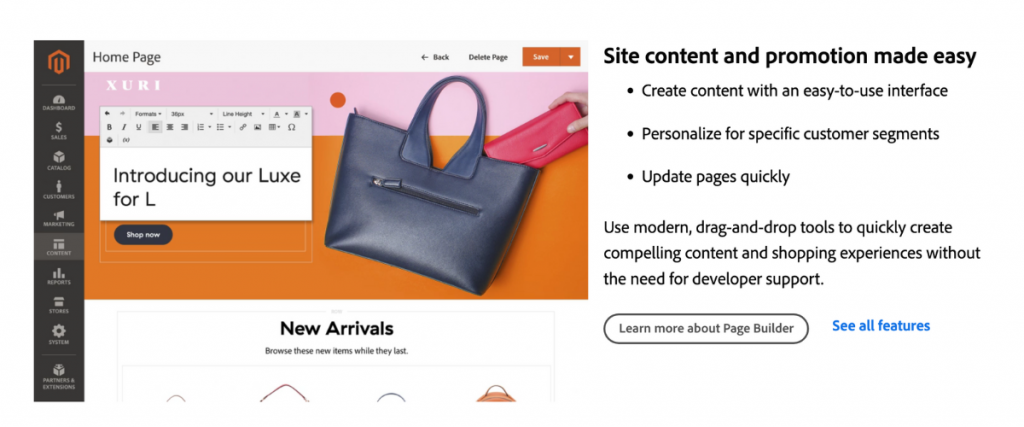
Inventory and order management tools enable you to maintain accurate inventory at all times. This is especially crucial if you have multiple stores and warehouses and you want to get into omnichannel retail. With real-time product inventory visibility, you can provide seamless customer experiences across different channels—let customers order online and pick up their products in-store or have them visit one of your physical shops and choose to have the products delivered to their home address.
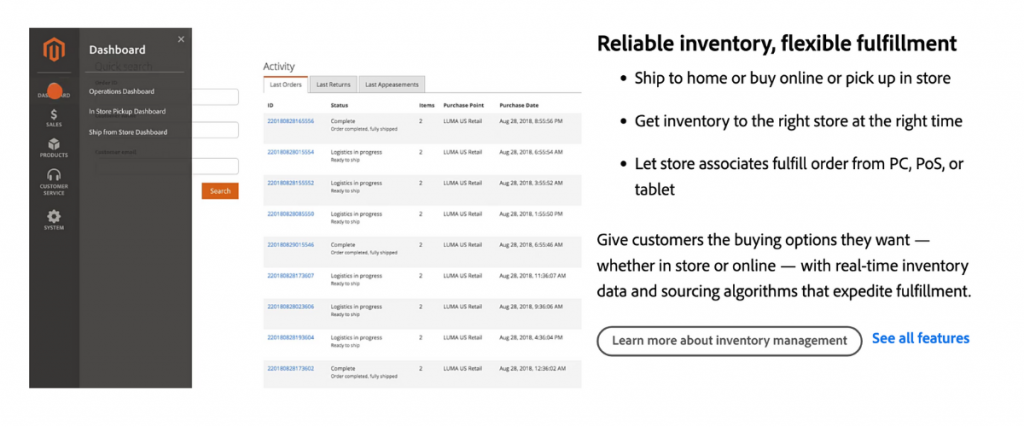
The B2B capabilities integrated with Adobe Commerce are designed to make B2B buying experiences for your customers as frictionless as possible. Customer-specific catalogs and pricing, quick order forms, order and quote tracking, and self-service customer portals are just some of the Adobe Commerce features that make managing orders easier for your B2B customers.
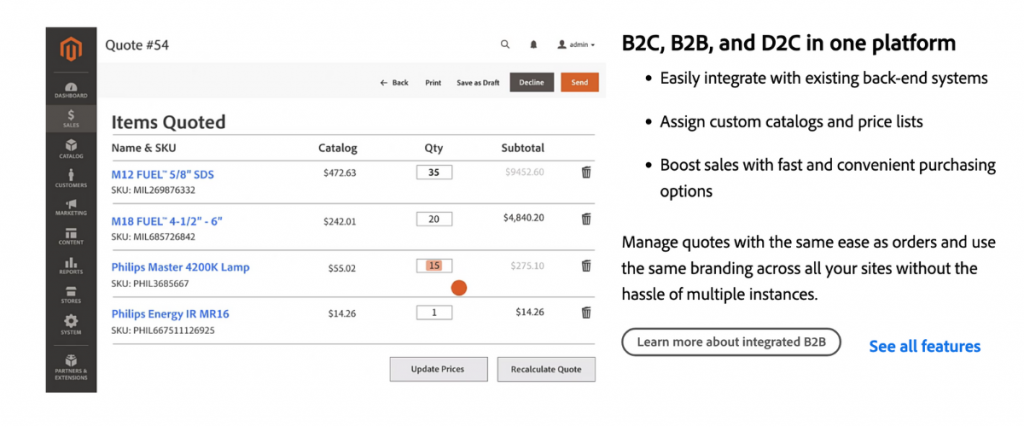
Business intelligence from Adobe Commerce comes with powerful report creation tools and rich visualization capabilities. Easily view customer lifetime value, retention rates, average order value, and other key metrics on a dashboard—monitor your business performance without dealing with complicated reports that are difficult to interpret. Insightful data about sales and customer behavior will help you make informed decisions during strategic planning and when designing marketing campaigns.
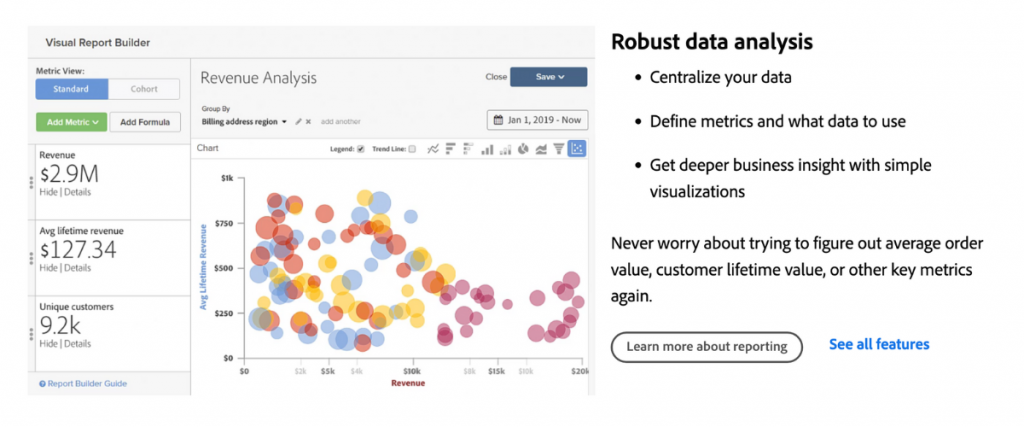
AI-powered functionality
Adobe Sensei
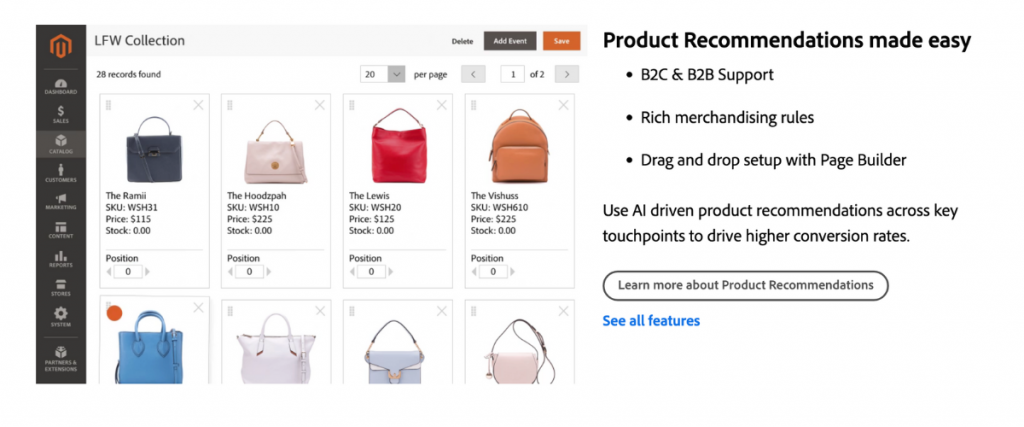
Adobe Sensei is an AI tool that underpins the Adobe Experience Cloud. It seamlessly works with all of Adobe’s cloud services to bring the power of artificial intelligence (AI) and machine learning (ML) to search, product recommendations, and merchandising.
Adobe Commerce Live Search delivers optimized results based on each user’s profile and previous behavior by combining Adobe Sensei with catalog data.
Product recommendations powered by Adobe Sensei are smart and personalized. In addition, tools are made available to merchants for managing custom attribute support in recommendation rules and for scoping recommendations on a category level.
AI-driven product recommendations and live search results deliver more relevant and personalized commerce experiences that improve conversion, retention, cross-sell, and up-sell.
Source: Adobe
With Adobe Sensei, merchandising is made more intuitive and intelligent. Dynamic digital shelves display products according to set rules combined with all relevant site information, with AI working to either boost or deprioritize results or categories automatically based on performance data.
Adobe Target
Adobe Target is Adobe’s solution for testing, automation, and personalization. Adobe Target allows merchants and marketers to personalize and experiment with content and experiences to improve revenue, conversions, and engagement across different customer touchpoints.
Adobe Sensei powers many of Adobe Target’s most innovative features, including automated personalization, auto-allocate, personalized insights reports, auto-target, and personalized recommendations.
Adobe Commerce Pricing
Adobe Commerce pricing is based on annual Gross Merchandise Value (GMV) and Average Order Value (AOV). Subscription cost per year starts at $20K, and that’s for a company with less than $1M average gross sales revenue.
What’s next in Adobe Commerce?
Watch Meet Magento Baltics 2022 panel discussion about what’s next in Adobe Commerce and eCommerce from Adobe, agency, and merchant sides. Eric Erway from Adobe, Maris Skujins from scandiweb, and Jonathan Ribas from Caudalie, give their thoughts on the latest Adobe Commerce updates and trends in online shopping.
Magento Open Source vs Adobe Commerce
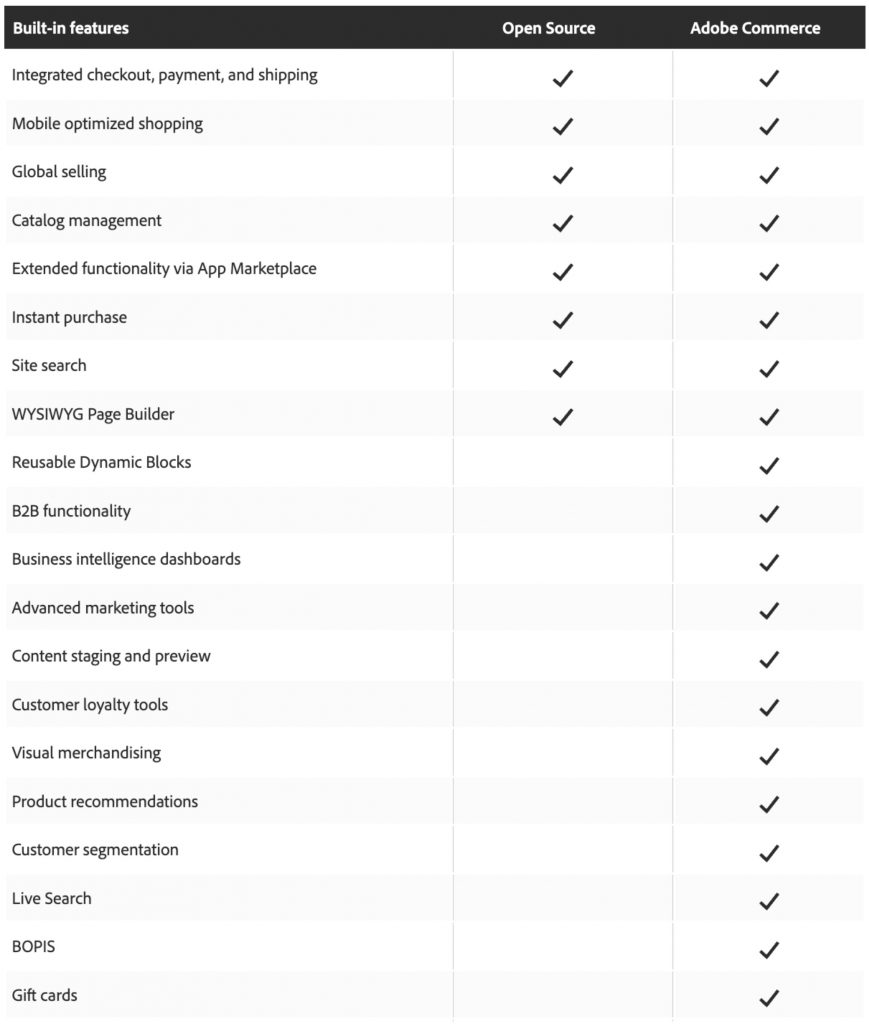
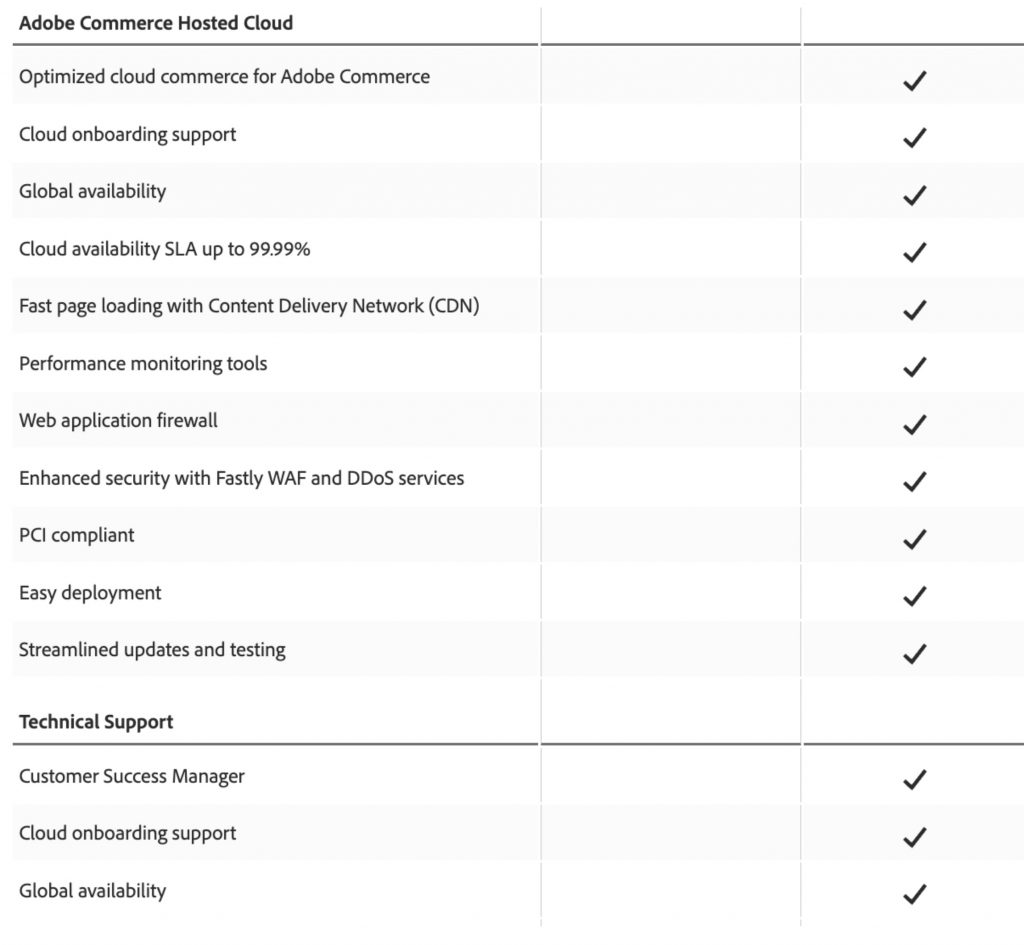
The main advantage of Magento Open Source over Adobe Commerce is that the platform itself is free. If you are a small retailer or just starting out, saving on platform costs is a huge benefit that you should definitely consider.
What makes Magento Open Source even better is that the platform is fully customizable. With all the extensions available on Adobe Commerce (Magento) Marketplace, many of the important eCommerce capabilities that aren’t built-in with the platform can be easily added. And Magento Open Source being customizable with extensible features makes it suitable for medium enterprises that demand more functionality, too.
On the other hand, Adobe Commerce is the best option for medium to large businesses that receive significantly higher traffic, have ambitious growth plans, and process a great volume of orders daily.
The advanced functionality, AI capabilities, elastic scalability, B2B features, and improved security of Adobe Commerce give enterprises a lot of room to grow and the ability to improve the commerce experiences they provide their customers at scales not possible with the Magento Open Source—which means much higher conversions, greater revenue, and more opportunities to excel at multichannel fulfillment.
If you are currently on Magento Open Source and finding that the platform is no longer meeting your needs, consider upgrading to Adobe Commerce. Not only will you have a more scalable and secure platform, but you will also get many advanced tools to improve your business operations, revenue performance, and the overall experience you provide your customers.
For more insights on when it might be time to move from Magento Open Source to Adobe Commerce, read this case study about how BUFF arrived at its decision to replatform to Adobe Commerce on cloud infrastructure and what came after the migration.
The business value of upgrading to Adobe Commerce
A 2022 research conducted by International Data Corporation (IDC) for Adobe looked at the value and benefits organizations received from upgrading to Adobe Commerce from Magento Open Source in running and supporting their digital commerce operations.
The study involved interviews with 11 organizations with 1 to 17,000 employees and reported annual revenue of $800,000 to $17 billion. The organizations had upgraded from Magento Open Source to Adobe Commerce and come from the following industries: retail/wholesale, automotive/transportation, financial services, professional services, and manufacturing.
Here’s what IDC found:
- Average annual benefit of $45,000 per 10,000 transactions
- 516% ROI in three years
- Improvements in several KPIs
- +18% in customer satisfaction scores
- +18% in average order values
- +15% in customer conversion rates
- 70% reduction in risk compared to Magento Open Source
With data backing up the benefits of upgrading to Adobe Commerce, the only question you need to settle is whether your business still has room to grow with Magento Open Source or you need to move to a more powerful platform to reach new heights of eCommerce success.
Explore our popular Adobe Magento services
Whether you’re looking to upgrade from Magento Open Source to Adobe Commerce or planning a new build, Scandiweb offers comprehensive Magento consulting services. We have delivered more than 250 Adobe Magento projects since 2009, and we fully understand that a mere platform launch is not a guarantee of success. Get in touch with one of our eCommerce experts today to know more about how Scandiweb can help you achieve your business goals.
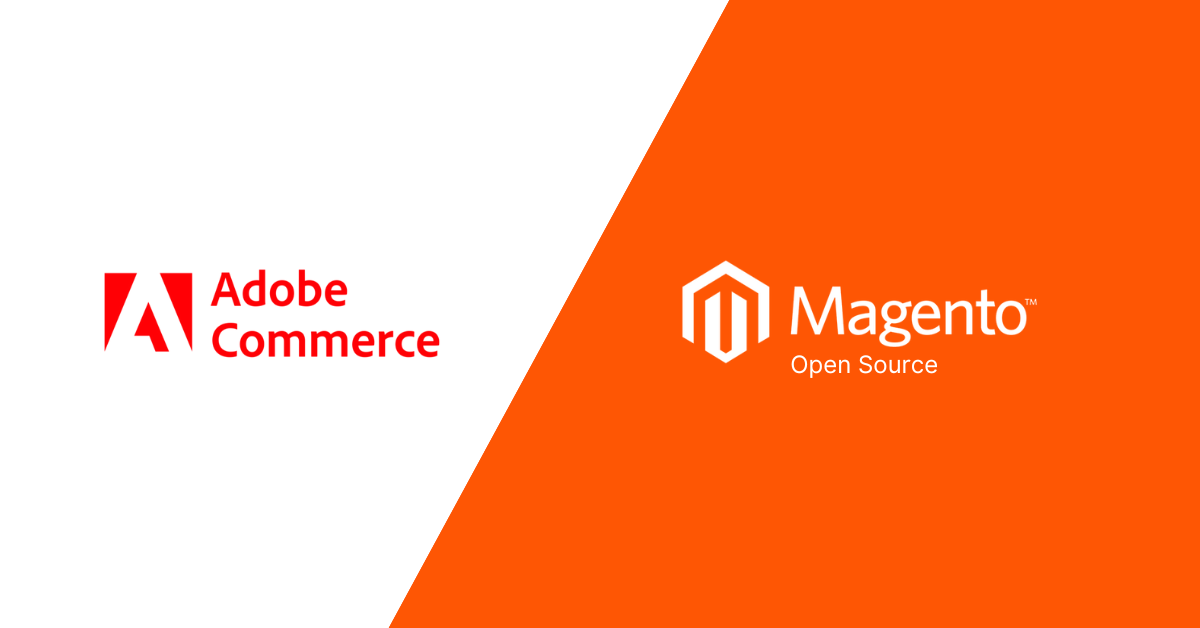

Share on: